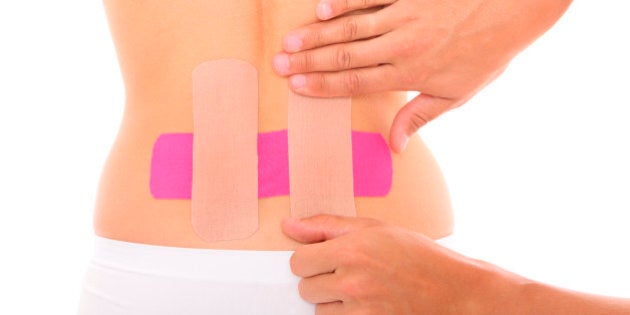
Sports medicine and weekend athletes alike may be borrowing something from Egyptology: Taping various parts of the body, mummy-style. You've likely seen the strips of brightly coloured tape stretching across the arms, legs and backs of many Olympic athletes. But today you'll find taping used by an increasing number of physiotherapists, even personal trainers.
My daughter's physio taped her back to help correct the wonky posture which had caused her neck pain; performance taping courses and seminars now abound; and a new book entitled Kinesiology Taping, even offers a do-it-yourself guide to this popular therapy. I used a pre-cut tape to clumsily tape a painful knee and was surprised at the support it provided. So what's it all about? Does it really help, or is it hype?
Kinesiology tape was originally invented by Japanese chiropractor Kenzo Kase more than 40 years ago. His Kinesio tape claims to alleviate pain, reduce inflammation, relax muscles and enhance performance while supporting muscles during a sporting event. Today, several brands of therapeutic tapes are on the market including Rock Tape, Kinesio, SpiderTech, and KT Tape, among others.
Therapeutic taping is an umbrella term that encompasses ridged taping, athletic taping, performance taping and kinesiology taping, says Dr. Nick Tsaggarelis, a licensed Toronto chiropractor who specializes in soft tissue and sports injuries and who has consulted for SpiderTech, a pre-cut elastic sports tape designed for anyone to use at home for sports injuries or strains.
Don't confuse this taping with the type of rigid athletic tape boxers use for their hands, or the kind of tape you use for hockey sticks or the duct tape that claims a thousand uses. This tape has the ability to stretch and contract, says Dr. Tsaggarelis. "It stimulates the tiny receptors in the skin to decrease the perception of pain or to correct posture. You place the tape on a body part and it provides a feeling of restriction, but not like with traditional athletic tape. Therapeutic tape, with its ability to expand and contract, moves with the body." Taping is wonderful for sprains and strains, he claims.
It's a supplemental type of therapy, not necessarily the first line of treatment. Dr. Tsaggarelis says it wouldn't be used on fractures, nor on anyone who has an intolerance to adhesives or an open wound or infection. In his view, taking a history and getting a proper diagnosis through imaging may be the way to go if something other than a minor ache or pain is suspected or if a trial of traditional alternative therapies are of no help. Stabilize is a word often used to describe what taping is really good for.
Kinesiology Taping, a book by John Langendoen and Karin Sertel, is a step-by-step guide to taping for "sports, fitness and daily life." Published by Robert Rose (www.robertrose.ca) its co-authors Langendoen, a Netherlands-based international sports physiotherapist and lecturer in musculo-skeletal physiotherapy and an expert in elastic taping, and Sertel, a physical therapist with a specialty in hand and cranio-sacral therapy, are huge advocates for self-taping, They say that taping protects injured tissues without restricting mobility and can be applied to all parts of the body where injured structures need to be supported and stabilized.
Dr. Tsaggarelis shows his clients how to tape themselves at home, but he cautions that learning how to do so from a book or YouTube video may not be helpful. There's a bit of a learning curve, he stresses. Learning how to tape from books or videos "is like learning to drive by reading a driver's manual." He thinks a consultation with a health provider who can demonstrate taping techniques is the best way to begin.
However pre-cut do-it-yourself products like Spider Tech tape are being bought for home use to treat everything from gardening strains to hamstring pulls. Its creator Dr. Kevin Jardine told Forbes that his tape "will simply allow you to forget about pain that would otherwise decrease your performance." That may be, although a review of evidence from ten research papers for Kinesio tape found no clinically important results for pain relief, inconsistent range-of-motion results but some positive effects on muscle activity and strength.
So is it the placebo effect, or have we not yet had enough studies? Probably a bit of both -- though what does it matter? Forbes.com reported that SpiderTech brings in revenues of $10 to $20 million annually, and coloured tapes are cropping up in sports and pharmacies around the world. It may be a fad, it may only be skin-deep, but its fans claim it provides drug-free feel-good therapy. And with colours ranging from neon pink to yellow, it's a lot funkier to wear than an ugly elastic knee brace.